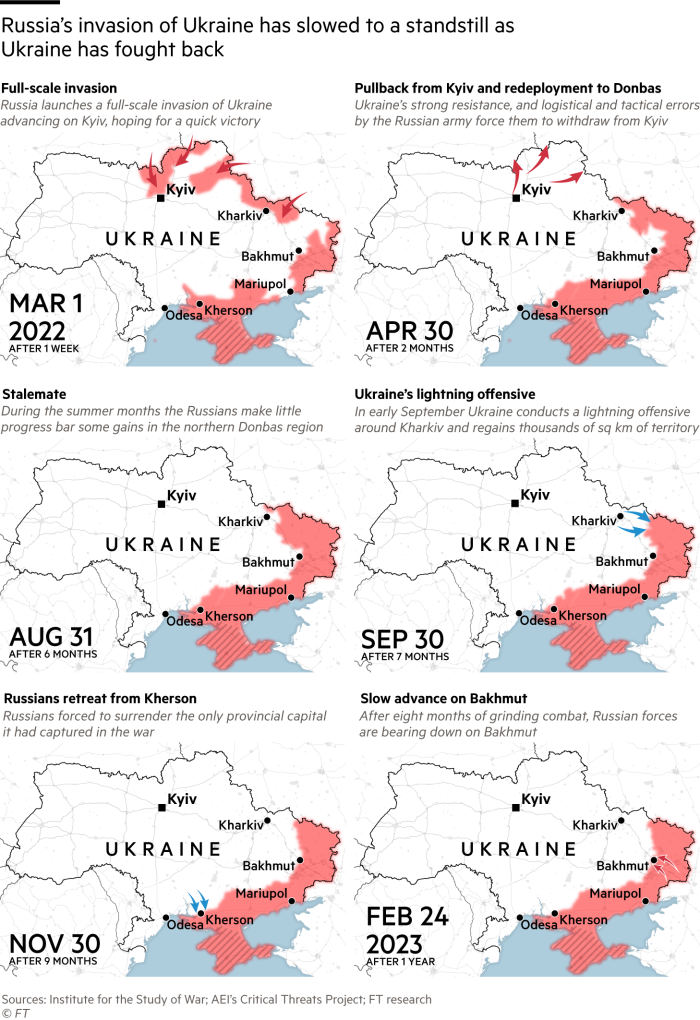Ukraine’s counteroffensive against Russia in maps — latest updates

We’ll send you a myFT Daily Digest email rounding up the latest War in Ukraine news every morning.
On February 24 2022, the world awoke to news that Russian tanks had rolled into Ukraine from the east and north. More than a year later, tens of thousands of casualties have been reported on both sides and millions of refugees from Ukraine have been recorded across Europe.
This page is regularly updated with the latest maps, charts, videos and satellite imagery showing military, environmental and humanitarian aspects of the war in Ukraine.
Latest on Ukraine’s counteroffensive
Skyscrapers in Moscow’s main business district were damaged by drone strikes on Sunday and Tuesday in the latest attacks on the Russian capital.
“There was an attack by Ukrainian drones,” Moscow mayor Sergei Sobyanin said on Sunday. “Several drones were shot down by air defences as they tried to enter Moscow. One hit the same tower as last time,” he added on Tuesday.
The attacks marks the fifth and sixth time that unmanned aerial vehicles have reached Moscow since May, when two drones were shot down over the Kremlin. Others drone strikes have hit buildings in suburban areas and also targeted fuel depots and air bases.
There was no immediate claim of responsibility from Kyiv. Ukraine has tended not to take direct credit for attacks on Russian territory.
Latest on the national picture
Russia attacked targets across Ukraine with drones on Wednesday, hitting a critical river port facility and a grain silo in the southern Odesa region.
Videos and photos posted by Odesa authorities and local media showed flames and massive damage to the port of Izmail, which lies on the Danube river across from Romania.
“Russian terrorists again attacked ports, grain and global food security. The world must respond,” Ukraine’s president Volodymyr Zelenskyy said. There were no casualties, but the drones had caused “significant damage”, he added.
Other maps and charts from the war
June 2023: Destruction of Kakhovka dam
Following the destruction of the Kakhovka dam in southern Ukraine on June 6, floodwaters devastated towns and villages downstream, with dozens of people perishing in the disaster amid patchy evacuation efforts in Russian-controlled territories. The flood also narrowed Ukraine’s attack options in its counteroffensive, which got under way in early June.
May 2023: Russian fortifications
Ukraine’s months-long preparation for its summer counteroffensive to try to wrest back occupied territory allowed Russia to fortify its positions along the almost 1,000km frontline.
Satellite images reviewed by the Financial Times and analysed by military experts revealed a multi-layered Russian network of anti-tank ditches, mazes of trenches, concrete “dragon’s teeth” barricades, steel “hedgehog” obstacles, spools of razor wire and minefields.
May 2023: Battle for Bakhmut
On May 21, Russia’s president Vladimir Putin hailed his first major victory since the early days of the full-scale invasion of Ukraine, claiming that Russian forces had captured the eastern city of Bakhmut, despite Kyiv insisting the battle “was not over”.
Putin said the Wagner paramilitary group had seized the Ukrainian city with help from Russia’s armed forces after months of bloody fighting that had caused more than 100,000 casualties and reduced the city to ruins.
Earlier in the year, satellite images from the Vuhledar area, south of Bakhmut in the Donetsk region, revealed the extent of damage in areas that had suffered intense artillery shelling.
September-November 2022: Ukraine retakes Kherson
A September counteroffensive led to Ukraine liberating 3,000 sq km of territory in just six days, its biggest victory since it pushed Russian troops back from Kyiv in March.
Ukraine’s forces continued to push east, capturing the transport hub of Lyman, near the north-eastern edge of the Donetsk province, which it wrestled from Russian control on October 1.
The hard-fought victory came after nearly three weeks of battle and set the stage for a Ukrainian advance towards Svatove, a logistics centre for Russia after its troops lost the Kharkiv region in the lightning Ukrainian counteroffensive.
Ukrainian forces advanced into Kherson on November 11 after Russia said its forces had completed their withdrawal from the southern city, sealing one of the biggest setbacks to Putin’s invasion.
Kyiv’s progress and Moscow’s chaotic retreat across the Dnipro river under Ukrainian artillery fire meant Russia surrendered the only provincial capital it had captured in the war, as well as ceding strategic positions.

March 2022: Russia fails to capture Kyiv
The Russians were thwarted in Kyiv by a combination of factors, including geography, the attackers’ blundering and modern arms, as well as Ukraine’s ingenuity with smartphones and pieces of foam mat.

The refugee crisis
The number of Ukrainians fleeing the conflict has made it one of the largest refugee crises in modern history.

Sources: Institute for the Study of War, Rochan Consulting, FT research.
Cartography and development by Steve Bernard, Chris Campbell, Caitlin Gilbert, Cleve Jones, Emma Lewis, Joanna S Kao, Sam Learner, Ændra Rininsland, Niko Kommenda, Alan Smith, Martin Stabe, Neggeen Sadid, Liz Faunce and Dan Clark.
Based on reporting by Roman Olearchyk, Christopher Miller, Max Seddon, John Paul Rathbone, John Reed, Guy Chazan, Henry Foy, Mehul Srivastava, Polina Ivanova and Tim Judah.







Comments